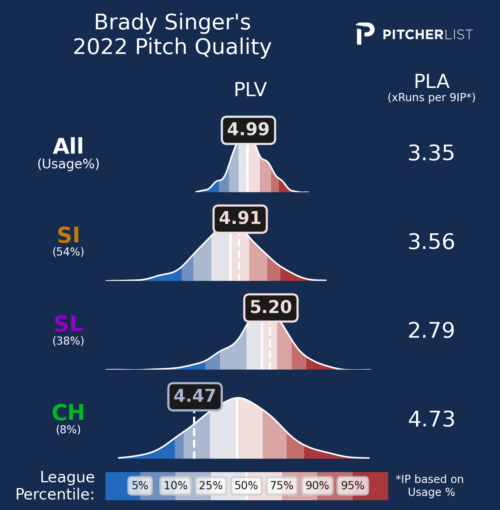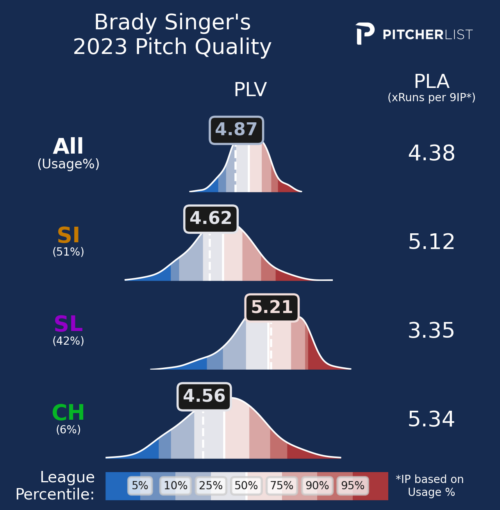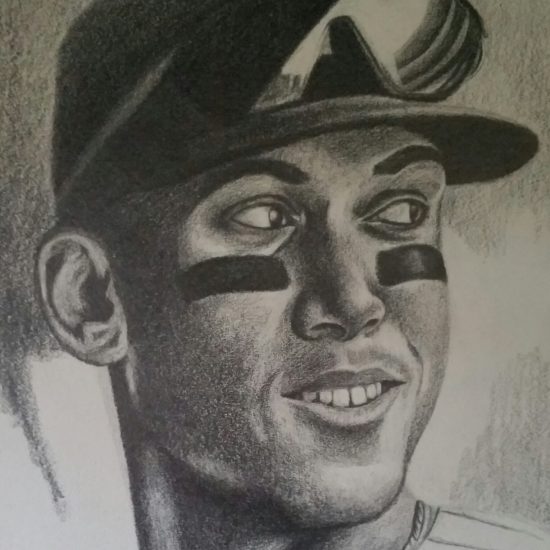This past offseason, Pitcher List introduced Pitch Level Value, or PLV, a new metric that assesses player performance by grading outcomes on the single pitch level. If you’re new to it, you can read Nick Pollack’s primer on PLV here.
You’ll find the definitions below. Grades are on a 20-80 scale.
Swing Aggression: How much more often a hitter swings at pitches, given the swing likelihoods of the pitches they face.
Strikezone Judgement: The “correctness” of a hitter’s swings and takes, using the likelihood of a pitch being a called strike (for swings) or a ball/HBP (for takes).
Decision Value (DV): Modeled value (runs per 100 pitches) of a hitter’s decision to swing or take, minus the modeled value of the alternative.
Contact Ability: A hitter’s ability to make contact (foul strike or BIP), above the contact expectation for each pitch.
Power: Modeled number of extra bases (xISO on contact) above a pitch’s expectation, for each BBE.
Hitter Performance (HP): Runs added per 100 pitches seen by the hitter (including swing/take decisions), after accounting for pitch quality.
Pitch Level Value (PLV): Estimated value of all pitches, based on the predicted outcome of those pitches (0-10, 5 is league average).
Pitch Level Average (PLA): Value of all pitches (ERA Scale), using IP and the total predicted run value of pitches thrown.
Pitch type PLA: Value of a given pitch type (ERA scale), using total predicted run values and an IP proxy for that pitch type (pitch usage % x Total IP).
(Note: All stats are current through Thursday, 8/3).
Franco was derailed by a couple of injuries that limited him to only 83 games last season. However, he demonstrated terrific contact ability (70). As a 22-year-old switch-hitter who was also baseball’s former top prospect, I think a lot of people were curious to see what he could do.
So what have we seen 105 games into year three? Aside from the 29 stolen bases (he’s also been caught ten times), he’s demonstrated a different approach at the plate going from what you’d consider an aggressive hitter (6.2% swing aggression last year) to a more passive one (-3.5%). The dip in his swing rate, though, hasn’t led to a change in his decision value compared to last year (45).
Despite striking out a bit more (14.1% vs. 9.6% last year), his contact ability remains near the top of the charts (70). And, yes, he’s more than doubled his home run total from last year: His power grade on PLV has risen a little bit from 45 to 50.
At first blush, Franco’s profile might not jump off the page but it’s very unique. There are only three other players (500 pitches minimum) with 70-grade contact ability and 50-grade power: José Ramírez, Vinnie Pasquantino (get well soon), and Bo Bichette.
He missed the first half of the season recovering from biceps and rotator cuff surgeries and has shown some thump with 11 home runs and a .829 OPS through 35 games (525 pitches).
He swings and misses a bit more these days (40 contact ability); Nevertheless, PLV confirms he does, in fact, still bang with a 65 in power. And he’s still got a sharp eye at the plate too: 70 in SZ Judgement and 65 in DV.
Well, shoot, hopefully, you bought low on Ryan Mountcastle. He’s gone gangbusters with a steamy 1.387 OPS over his last 11 games.
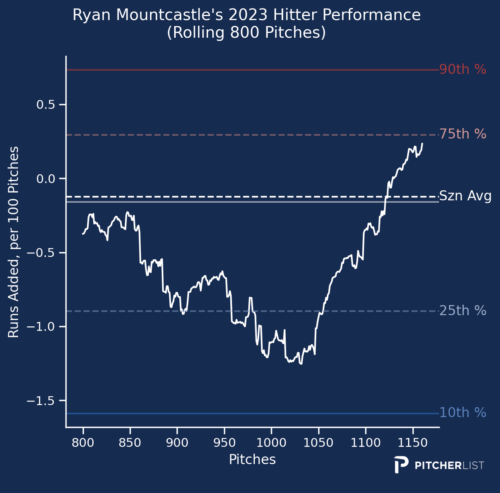
Mountcastle isn’t someone who will typically take a lot of pitches (8.7% swing aggression) but he’s shown a little bit better contact ability this season (55) compared to last year (50). His power is down slightly (60) compared to last year (65). But I get the sense that will even out when it’s all said and done. He should be a very important part of the Orioles’ lineup as they push for a playoff spot, although he might miss hitting north of the border.
Highest batting average in 4+ game series, since 1900 (min 15 PA):
2020 Adalberto Mondesi vs DET: .857
2023 Ryan Mountcastle at TOR: .846
1961 Norm Cash vs BOS: .818
1962 Lu Clinton vs MIN: .800
1927 Joe Harris vs PHI: .800
1916 Joe Jackson at DET: .800h/t @EliasSports https://t.co/GVOX3Wk0vB
— Sarah Langs (@SlangsOnSports) August 4, 2023
We’ve got Gallen gals, so why not Sal pals? OK, I’ll stop. Sal Frelick, the 15th overall pick two years ago, has given the Brew Crew a much-needed boost with a .950 OPS over his first dozen games. His 13% K rate is what you’d expect after perusing his prospect report but the .515 SLG is an interesting wrinkle.
We’re cutting corners because the sample size is really small (183 pitches). But so far, he’s shown good contact ability (55) and slightly below-average power (45). And as you might’ve guessed based on his high walk rate, he’s been passive at the plate with a -9.3% swing aggression, meaning he swings significantly less than expected based on the quality of the pitch.
Contact ability Risers and Fallers
James Outman not only has a 1.027 OPS in the second half (18 games) but he’s also walking (22.4%) more than he’s striking out (20.9%).
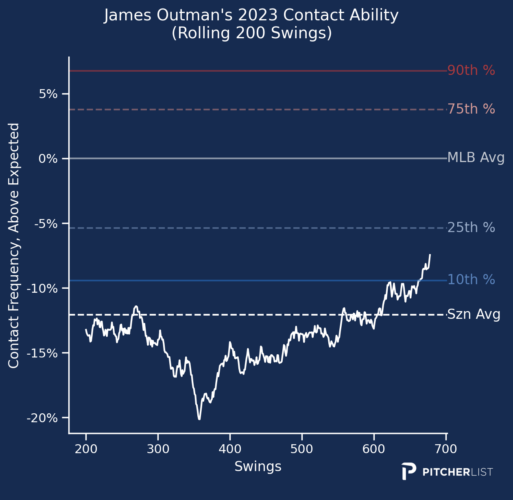
Jarren Duran’s strikeout rate has dropped from 26.7% in the first half to 16.2% through the first 18 games of the first half.
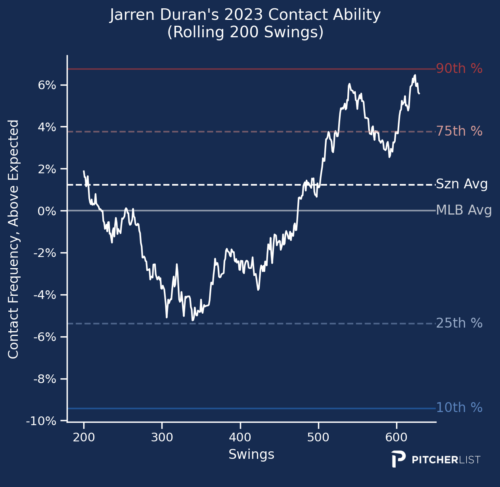
Josh Lowe is the faller. His strikeout rates by month: April: 20.5%, May: 24.4%, June: 30.9%, July: 34.3%.
His K rate is 23.4% in the second half so far (16 games).

Cal Raleigh impressed last year by banging out 27 home runs with a .773 OPS and seemed like a fairly decent late-round target at C. He’s been on a roll of late hitting five home runs over his last 11 games. Contact was an issue last year (40), but he’s improved there this year (45) while still showing off excellent power (60). This year, it seems like he’s been a little more patient at the plate with a 2.9% swing aggression as opposed to 6.0% last season.
There were rumblings about Flaherty using his cutter more with his new team. Full disclosure: it depends on your source as the cutter and slider labels are often mixed up. On Savant, he threw 26 cutters (28%) and the pitch returned an impressive 46% CSW.
His game log on the PL player pitch, though, tracked only 12 cutters (13%) with the pitch returning a less impressive 4.19 PLV / 5.85 PLA.
However, his slider (19 pitches / 20.7%) passed the test and then some with a terrific 5.73 PLV / 1.19 PLA.
We’ve seen Flaherty oscillate so much this year that it’s hard to tell what to expect. Again, the pitch classifications for a slider vary between PLV and Savant. With that in mind, his cutter has graded really well this year with a 5.54 PLV / 2.49 PLA. So if he does, in fact, lean on the cutter more, Flaherty might be primed for a strong finish. We shall see.
He’s been operating as the Angels interim leadoff hitter. Truthfully, the Angels don’t have a great option at the moment. Still, he’s been productive with a .910 OPS over his last 13 games. And he did have a decent July last year (.825 OPS) so we’ve seen it before.
So is there any staying power this time around? Maybe. His swing aggression is down noticeably this year from 9.8% to 2.2%. His decision value has increased this year (45 to 55). Neither his contact ability (50) nor power (45) moves the needle. Still, I’m a little interested in him because he seems to be swinging at better pitches. You’d figure he’ll see his fair share of good pitches to pummel now that he’s hitting in front of Shohei Ohtani.
One thing to note: He’s shown very stark splits with a .317 wOBA as a right-handed hitter versus .283 as a left-handed hitter.
While the armchair physician in me wonders how it took so long for Anthony Rizzo to be diagnosed with post-concussion symptoms, it clears the way for Jake Bauers. He’s third on the Yankees with a .776 OPS. Granted, that’s probably more of an indictment on the rest of their roster but Bauers and his 75-grade power has piqued my interest.
Nootbaar was a popular sleeper this past offseason posting a .480 SLG and a 1:1 K: BB ratio in the second half of 2022. The big breakout didn’t happen in the first half, although the OBP was still excellent.
And then he went out and nearly doubled his home run total by swatting five home runs over his last 12 games.
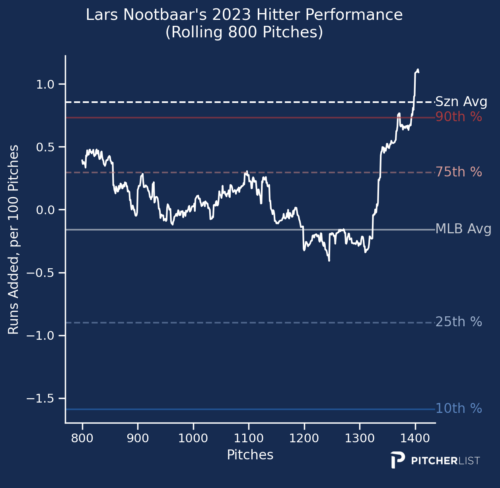
Granted his curveball and cutter grades this year are still good but they just don’t seem to match the remarkable results. Regression? Sure, of course. No one can hold a 2.34 ERA for long. Then again, the Rays always (always!) win these sorts of trades.
